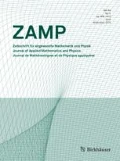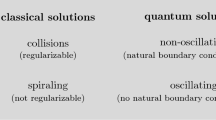Abstract
In this paper, we determine in second order in the fine structure constant the energy levels of Weber’s Hamiltonian that admit a quantized torus. Our formula coincides with the formula obtained by Wesley using the Schrödinger equation for Weber’s Hamiltonian. We follow the historical approach of Sommerfeld. This shows that Sommerfeld could have discussed the fine structure of the hydrogen atom using Weber’s electrodynamics if he had been aware of the at-his-time-already-forgotten theory of Wilhelm Weber (1804–1891).

Similar content being viewed by others
Notes
Differences of these energy levels give rise to the Rydberg formula
$$\begin{aligned} \frac{1}{2n^2}-\frac{1}{2m^2},\quad n,m\in {\mathbb {N}}, m>n, \end{aligned}$$that corresponds to the energy of the emitted photon when an electron falls from an excited energy level to a lower one. Historically these differences were first measured in spectroscopy. In 1885, the Swiss school teacher Balmer discovered the formula for the \(n=2\) series, nowadays referred to as the Balmer series; cf. [25, p. 163].
References
Albers, P., Frauenfelder, U., Schlenk, F.: What might a Hamiltonian delay equation be? arXiv:1802.07453 (2018)
Albers, P., Frauenfelder, U., Schlenk, F.: A compactness result for non-local unregularized gradient flow lines. J. Fixed Point Theory Appl. 21(1):Art. 34, 28 (2019). arXiv:1802.07445
Albers, P., Frauenfelder, U., Schlenk, F.: An iterated graph construction and periodic orbits of Hamiltonian delay equations. J. Differ. Equ. 266(5), 2466–2492 (2019). arXiv:1802.07449
Assis, A.K.T.: Weber’s Electrodynamics. Springer, Dordrecht (1994)
Belbruno, E.A.: Two-body motion under the inverse square central force and equivalent geodesic flows. Celest. Mech. 15(4), 467–476 (1977)
Bohr, N.: On the constitution of atoms and molecules, part I. Philos. Mag. 26(151), 1–24 (1913)
Bush, V.: The force between moving charges. J. Math. Phys. 5(1–4), 129–157 (1926)
Darwin, C.G.: The wave equations of the electron. Proc. R. Soc. Lond. Ser. A 118, 654–680 (1928)
Einstein, A.: Zum Quantensatz von Sommerfeld und Epstein. Deutsche Physikalische Gesellschaft Verhandlungen 19, 82–92 (1917)
Frauenfelder, U.: State dependent Hamiltonian delay equations and Neumann one-forms. arXiv:1904.01808 (2019)
Gordon, W.: Die Energieniveaus des Wasserstoffatoms nach der Diracschen Quantentheorie des Elektrons. Zeitschrift für Physik 48(1), 11–14 (1928)
Goursat, E.: Sur les transformations isogonales en Mécanique. Comptes Rendus des Séances de l’Académie des Sciences 108, 446–448 (1889)
Graneau, P., Graneau, N.: Newtonian Electrodynamics. World Scientific Publishing Co., Inc., River Edge (1996)
Gutzwiller, M.C.: Chaos in Classical and Quantum Mechanics, volume 1 of Interdisciplinary Applied Mathematics. Springer, New York (1990)
Hofer, H., Wysocki, K., Zehnder, E.: Polyfold and Fredholm Theory. arXiv:1707.08941 (2017)
Hofer, H., Zehnder, E.: Symplectic Invariants and Hamiltonian Dynamics. Modern Birkhäuser Classics. Birkhäuser Verlag, Basel (2011). Reprint of the 1994 edition
Keppeler, S.: Semiclassical quantisation rules for the Dirac and Pauli equations. Ann. Phys. 304(1), 40–71 (2003)
Keppeler, S.: Spinning Particles—Semiclassics and Spectral Statistics. Springer, Berlin (2003)
Lamb, W.E., Retherford, R.C.: Fine structure of the hydrogen atom by a microwave method. Phys. Rev. 72, 241–243 (1947)
Levi-Civita, T.: Sur la régularisation du problème des trois corps. Acta Math. 42, 99–144 (1920)
Maxwell, J.C.: On Faraday’s lines of force. Trans. Camb. Philos. Soc. X(I.), 155–229 (1855)
Maxwell, J.C.: A Treatise on Electricity and Magnetism, vol. I. Clarendon Press, Oxford (1873)
Milnor, J.: On the geometry of the Kepler problem. Am. Math. Mon. 90(6), 353–365 (1983)
Moser, J.: Regularization of Kepler’s problem and the averaging method on a manifold. Commun. Pure Appl. Math. 23, 609–636 (1970)
Mehra, J., Rechenberg, H.: The Historical Development of Quantum Theory, volume 1, Part 1—The Quantum Theory of Planck, Einstein, Bohr and Sommerfeld: Its Foundation and the Rise of its Difficulties 1900–1925. Springer, New York (1982)
Mehra, J., Rechenberg, H.: The Historical Development of Quantum Theory, volume 5—Erwin Schrödinger and the Rise of Wave Mechanics, Part 2—The Creation of Wave Mechanics; Early Response and Applications 1925–1926. Springer, New York (1987)
McDuff, D., Salamon, D.: Introduction to Symplectic Topology. Oxford Graduate Texts in Mathematics, 3rd edn. Oxford University Press, Oxford (2017)
Neumann, C.: Die Principien der Elektrodynamik: eine mathematische Untersuchung. Tübinger Universitätsschriften a. d. J. 1868. H. Laupp, 1868. Reprinted In Mathematischen Annalen, vol. 17, pp. 400–434 (1880)
Neumann, C.: Theoria nova phaenomenis electricis applicanda. Ann. Mate. Pura Appl. (1867–1897) 2(1), 120–128 (1868)
Neumann, C.: Allgemeine Untersuchungen über das Newton’sche Princip der Fernwirkungen: mit besonderer Rücksicht auf die elektrischen Wirkungen. B. G. Teubner, Leipzig (1896)
Osipov, Y.S.: The Kepler problem and geodesic flows in spaces of constant curvature. Celest. Mech. 16(2), 191–208 (1977)
Schweber, S.: QED and the Men Who Made It: Dyson, Feynman, Schwinger, and Tomonaga. Princeton University Press, Princeton (1994)
Sommerfeld, A.: Zur Quantentheorie der Spektrallinien. Ann. Phys. 356(17), 1–94 (1916)
Sommerfeld, A.: Atombau und Spektrallinien. Friedrich Vieweg und Sohn (Braunschweig), Zweite Auflage (1921)
Thomson (Lord Kelvin), W., Tait, P.G.: Treatise on Natural Philosophy, vol. I. Clarendon Press, Oxford (1867)
Thomson (Lord Kelvin), W., Tait, P.G.: Handbuch der Theoretischen Physik. Erster Band. Erster Theil. Translated by H. Helmholtz and G. Wertheim. Friedrich Vieweg und Sohn (Braunschweig) (1871)
Thomson (Lord Kelvin), W., Tait, P.G.: Treatise on Natural Philosophy, volume I, Part I, new edition. Cambridge University Press, Cambridge (1879)
von Helmholtz, H.: Über die Erhaltung der Kraft. Humboldt-Universität zu Berlin, Berlin (1847)
Weber, W.: Elektrodynamische Maassbestimmungen über ein allgemeines Grundgesetz der elektrischen Wirkung. Abhandlungen bei Begründung der Königl. Sächs. Gesellschaft der Wissenschaften am Tage der zweihundertjährigen Geburtstagfeier Leibnizen’s (1846). Reprinted in Wilhelm Weber’s Werke (Springer, Berlin, 1893), vol. 3, pp. 25–214
Weber, W.: Elektrodynamische Maassbestimmungen insbesondere Zurückführung der Stromintensitäts-Messungen auf mechanisches Maass. Abhandlungen der Königl. Sächs Gesellschaft der Wissenschaften 3, 221–290 (1857). Reprinted in Wilhelm Weber’s Werke (Springer, Berlin, 1893), Vol. 3, pp. 609–676
Weber, W.: Elektrodynamische Maassbestimmungen insbesondere über das Princip der Erhaltung der Energie. Abhandlungen der Königl. Sächs Gesellschaft der Wissenschaften 10, 1–61 (1871). Reprinted in Wilhelm Weber’s Werke (Springer, Berlin, 1894), Vol. 4, pp. 247–299
Wesley, J.P.: Evidence for Weber–Wesley electrodynamics. In: Proceedings Conference on Foundations of Mathematics and Physics, Perugia, Italy, 27–29 September 1989, pp. 289–343 (1989)
Wiederkehr, K.H.: Wilhelm Eduard Weber; Erforscher der Wellenbewegung und der Elektrizität 1804–1891. Band 32 Große Naturforscher. Wissenschaftliche Verlagsgesellschaft M.B.H, Stuttgart (1967)
Wolfschmidt, G., Assis, T., Koch, A.: Wiederkehr, Karl Heinrich: Weber’s Planetary Model of the Atom. Tredition, Hamburg (2011)
Wolfschmidt, G., Assis, T., Koch, A.: Wiederkehr, Karl Heinrich: Weber’s Planeten-Modell des Atoms. Apeiron, Montreal (2018)
Zöllner, J.K.F.: Über die Natur der Cometen: Beiträge zur Geschichte und Theorie der Erkenntnis. Engelmann (Leipzig) (1872)
Acknowledgements
The authors would like to thank sincerely André Koch Torres Assis for many useful conversations about Weber’s electrodynamics. The paper profited a lot from discussions with Peter Albers and Felix Schlenk about delay equations whom we would like to thank sincerely as well. This article was written during the stay of the first author at the Universidade Estadual de Campinas (UNICAMP) that he would like to thank for hospitality. His visit was supported by UNICAMP and Fundação de Amparo à Pesquisa do Estado de São Paulo (FAPESP), processo \(\mathrm {n}^{\mathrm{o}}\) 2017/19725-6.
Author information
Authors and Affiliations
Corresponding author
Additional information
Publisher's Note
Springer Nature remains neutral with regard to jurisdictional claims in published maps and institutional affiliations.
Appendices
Weber’s Lagrangian and delayed potentials
In several works, Neumann treated the connection between Weber’s dynamics and delayed potentials, see [28, 29] and [30, Ch. 8]. Neumann explained how Weber’s potential function is related to Hamilton’s principle which in [29] he called “norma suprema et sacrosancta, nullis exceptionibus obvia”.
Strictly speaking, a delay potential only makes sense for loops and not for chords. Hence we abbreviate by \({\mathcal {L}}=C^\infty \big (S^1, {\mathbb {R}}^2_\times \big )\) the free loop space on the punctured plane \({\mathbb {R}}^2_\times :={\mathbb {R}}^2 {\setminus } \{0\}\). For a potential \(V \in C^\infty \big ({\mathbb {R}}^2_\times ,{\mathbb {R}}\big )\) and a constant \(c _{\mathrm{W}}>0\), we define three functions
by \({\mathcal {S}}={\mathcal {S}}_{\mathrm {kin}}-{\mathcal {S}}_{\mathrm {pot}}\) and by
Physically this means that the potential energy is evaluated at a retarded time. Namely, the position of the proton at the origin has to be transmitted to the electron at speed \(c_{\mathrm{W}}\). It is a strange fact that to obtain Weber’s force this transmission velocity is given by the Weber constant \(c_{\mathrm{W}}\) which, as measured by Weber [40], equals \(\sqrt{2} c\) where c is the speed of light.
We assume that V only depends on the radial coordinate \(V(q)=V(|q|)=V(r)\). Setting \(r(t):=\mathopen |q(t)\mathclose |\) the functional \({\mathcal {S}}_{\mathrm {pot}}\) becomes a function of \(r=r(t)\), still denoted by
We further abbreviate
where \(\alpha \) is the fine structure constant.
Setting \(V_r( a,t):=V\big (r\big (t- a r(t)\big )\big )\), we obtain for the partial derivatives in a the formulas
and
In particular, at \(a=0\) we get
and
We define
For \(k=0\) this is the unretarded action functional
To see that \({\mathcal {S}}^1_{\mathrm {pot}}\equiv 0\) vanishes identically choose a primitive F of the function in one variable \(r\mapsto V'(r) r\), that is \(F'(r)=V'(r) r\). Indeed, we get that
The last equation follows, because \(r(t)=\mathopen |q(t)\mathclose |\) is periodic. Using integration by parts for the second term in the sum we get that
For the Coulomb potential
this simplifies to
Hence Taylor approximation of \({\mathcal {S}}_{\mathrm {pot}}\) to second order in \(a=\frac{1}{c_{\mathrm{W}}}\) leads to
where
is Neumann’s potential function, see (2.1), and \(2c^2=c _{\mathrm{W}}^2\).
Proton-proton system—Lorentzian metric
For a positive charge influenced by the proton, the Weber force exhibits fascinating properties as well. For simplicity, suppose both charges are protons and set their mass equal to one. In this case, the Lagrangian function is given by
Changing brackets
Now the metric gets singular at Weber’s critical radius
Outside Weber’s critical radius, the metric is Riemannian, while inside it is Lorentzian. An interesting aspect of Weber’s critical radius is that while outside Weber’s critical radius the force is repulsing—inside it is attracting! This led Weber to predict—40 years before Rutherford’s experiments—an atom consisting of a nucleus built of particles of the same charge together with particles of the opposite charge moving around the nucleus like planets. For more informations about Weber’s planetary model of the atom see [44, 45].
Rights and permissions
About this article
Cite this article
Frauenfelder, U., Weber, J. The fine structure of Weber’s hydrogen atom: Bohr–Sommerfeld approach. Z. Angew. Math. Phys. 70, 105 (2019). https://doi.org/10.1007/s00033-019-1149-4
Received:
Revised:
Published:
DOI: https://doi.org/10.1007/s00033-019-1149-4



